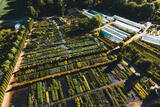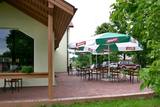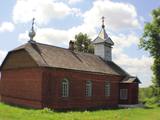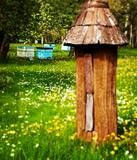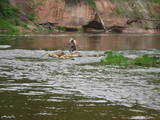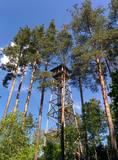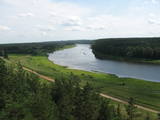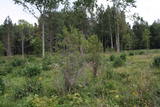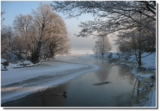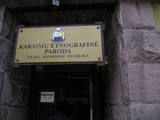| Nr | Nosaukums | Apraksts |
|---|---|---|
|
Viena no bagātākajām un ainaviski skaistākajām Latvijas kokaudzētavām. Tās piedāvājumā ir ~ 1000 dažādu kokaugu sugu, šķirņu un formu. Spēcīga ražošanas bāze. Moderns aprīkojums- trīs podojamās mašīnas, laistīšanas sistēmas, augu transports, liela izmēra koku rakšanas tehnika, liela siltumnīcu saimniecība utt. |
||
|
Kafejnīca "Krūziņi" atrodas Dundagas centrā, viesu namā „Krūziņi”. Latviešu virtuve: Skābu kāpostu zupa, pelēkie zirņi ar rūgušpienu, cepta bute vai menca, skābzupa ar kartupeli. Īpašais ēdiens: „Biezpiena tornītis” vai krēms no Dundagas pienotavas produktiem. |
||
|
Ģimenes uzņēmums Svētes pagastā, netālu no Jelgavas. Kopš 2019.gada šeit top dažādi Latvijas priežu produkti, kas vērtīgi kā imunitātei, tā arī veselībai. Mītavas Čiekurs produktu galvenā sastāvdaļa ir Parastā priede (Pinus sylvestris). Tā bagāta ar ēterisko eļļu, sveķiem, miecvielām, C vitamīnu u.c. vērtīgām vielām. Tiek gatavotas priežu čiekuru karameles, čiekuru sīrupa zefīri, želejkončas, priežu čiekuru zapte, karamelizēti čiekuri sīrupā, šokolādē, kā arī priežu pumpuru sīrups un tēja. Ekskursija norisinās 90-120 minūtes, kuru laikā atraktīvais saimnieks Reinis pastāstīs par uzņēmuma vēsturi, dalīsies receptēs, pagatavos katram apmeklētājam gardu dāvanu (čiekuru marmelādi), kā arī protams- varēs degustēst dažādos priežu produktus. Papildu pirms vai pēc ekskursijas iespējams ieturēties ar uz ugunskura gatavotu pupiņu zupu ar lauku kūpinājumiem, soļanku vai biešu zupu. Tūristus uzņem nupat uzbūvētajā ekskursiju telpā- Čiekurnīcā. Uzņemt var līdz pat 60 interesentiem reizē. |
||
|
Resnākā un varenākā Latvijas parastā egle (Picea abies). Neparasts ir tās monolītais un nelieliem dobumiem izrobotais stumbrs. Egle meklējama aizaugušajā Īves muižas parkā, aiz muižas pils drupām.
|
||
|
Taarka Tarõ Köögikõnõ atrodas tradicionālajā setu zemnieku sētā, kur bez setu tradicionālajiem ēdieniem piedāvā arī citu somugru tautu un arī ukraiņu ēdienu garšas. |
||
|
Borisovas vecticībnieku kopienas lūgšanu nams uzcelts laika
posmā no 1911. līdz 1921. gadam. Atšķirībā no citiem lūgšanu
namiem apkaimē Borisovas dievnams ir veidots no ķieģeļiem un atrodas kalna pakājē. Zvans šim dievnamam speciāli tika pasūtīts Pēterburgā, un tas izceļas ar savu īpaši maigo skanējumu.
|
||
|
Skaistā lauku sētā Ventspils novadā, netālu no jūras dzīvo ģimene, kura jau vairāk kā 40 gadus nodarbojas ar biškopību. Apmeklētāju vajadzībām uzbūvēts veikaliņš un degustāciju zāle. Dažādu ziedu medus, ziedputekšņu (arī medū), propolisa (arī medū), bišu maizes, vaska sveču un suvenīru iegāde. Biškopības produktu (t.sk. medus vīna) degustācija un ekskursija. Jaunums - Bišu Dziedinātava! Brīnišķīga iespēja uzlabot gan garīgo, gan fizisko veselību ar apiterapijas - bišu dziedinošā spēka ārstniecisko iedarbību. |
||
|
Tammes dārzniecība ir alternatīvās ražošanas saimniecība, kurā var iepazīties ar ārstniecības augu un garšaugu paraugdārzu. Šeit audzē arī neparastus dārzeņus un kulinārijā izmantojamos dekoratīvos augus. Ja pieteiksieties iepriekš, pēc izglītojošas pastaigas saimniece pacienās ar aromātisku zāļu tēju un pīrādziņiem. Tepat veikalā var nopirkt garšīgus ievārījumus, dārzeņu un garšaugu konservus, garšaugu un drogu maisījumus, kā arī citus savdabīgus produktus. |
||
|
No dārza un meža ogām, pārmantojot paaudžu tradīcijas, gatavo mājas vīnu. Piedāvā 4 vīnu degustāciju ar uzkodām un filozofiskas sarunas par vīna gatavošanas receptēm. Produkcijas iegāde. |
||
|
Ģeoloģiskā taka sastāv no trīs saistītiem posmiem: „Melturi – Kārļu zivjaudzētava”, „Kārļu zivjaudzētava – Zvārtes iezis” un "Zvārtes iezis - Veclauču tilts". Amatas senleja veidojusies vienlaikus ar Gaujas senleju leduslaikmeta beigu posmā un pēcleduslaikmetā, ledāja kušanas ūdeņiem plūstot uz Gaujas ieleju. Gaujas NP teritorijā Amatas senielejas dziļums sasniedz 50 metrus un platums palielinās līdz apmēram 1-1,5km.
Augstas kraujas (vairāk ne kā 40 metru), kurās redzami augšdevona Pļaviņu svītas dolomītu un augšdevona Amatas un Gaujas svītu smilšakmeņu atsegumi, mijas ar mežiem apaugušām, 3-16m augstām stāvām terasēm.
Amatas senieleja ir nozīmīga ne tikai ar savām dabas ainavām. Tās krastus grezno dolomīta un smilšakmens atsegumi, kas atklāj zemes vēstures lappuses 350-400 miljonu gadu tālā pagātnē, kad Latvijas teritoriju klāja jūra.
Velobraucieniem taka nav piemērota!
|
||
|
Uzcelts apkaimes augstākajā vietā – Ančupānu meža kalnā, kuru vietējie dēvē par „Bāku”. No 26 m augstā torņa redzama ļoti plaša panorāma ar Rēzeknes pilsētas namiem, baznīcu torņiem un apkaimes mežu masīviem, kas mijas ar lauksaimniecībā izmantojamām zemēm. Blakus tornim – atpūtas vieta. |
||
|
1996. g. atklātais piemineklis (tēlniece: A. Veinbaha) Dagdā (starp Asūnes un Rēzeknes ielām) ir piemiņas vieta komunisma terora upuriem. No šejienes paveras labs skats uz salām bagāto Dagdas ezeru. |
||
|
Dabas resursu, dabas, ainavas, bioloģiskās daudzveidības un kultūras pieminekļu ziņā – viens no bagātākajiem un ainaviski neparastākajiem Latvijas dabas parkiem, kura galvenā „vērtība” ir mazskartā Daugavas vidusteces ieleja ar astoņiem lieliem lokiem (garums 4 – 8 km) un tās pieteku gravām. Izcilas ainavas paveras no Daugavas ielejas stāvajiem krastiem, īpaši Slutišku un Ververu kraujām un Elernes grants kalna, kā arī citām vietām. Ielejas krastos atrodas divi desmiti dažādu arheoloģijas pieminekļu, senie senču pilskalni - Naujenes, Markovas, Vecračinas u.c., neskaitāmi dievnami - Juzefovas, Spruktu, Borovkas, Elernes, Sīķeles, Kaplavas u.c., muižas (Rozališku, Lielbornes u.c.), kā arī unikālā vecticībnieku apdzīvotā Slutišku sādža, kurā apmeklētājiem izveidota muzeja ekspozīcija. Parka teritorijā atrodas arī interesantas dabas takas, velomaršruti, var veikt pārgājienus ar zirgiem. Nesen Krāslavā uzcelts jauns un moderns skatu tornis. Saistošs ir nobrauciens pa Daugavu ar laivām. Dabas parks ietilpst lielākā īpaši aizsargājamā dabas teritorijā - Augšdaugavas aizsargājamo ainavu apvidū. |
||
|
Viena no nedaudzajām Latvijas vietām (ap kilometru ziemeļrietumos no Lapmežciema), kur savulaik bijušas skaistas kadiķu pļavas. Kopš šajā vietā vairs nenotiek saimnieciskā darbība (pļaušana, lopu ganīšana) kadiķu pļavas aizaug un daudzi kadiķi jau ir aizgājuši bojā. Lai šo teritoriju turpmāk saglabātu tāda, kāda tā ir bijusi, tai nepieciešama regulāra apsaimniekošanas pasākumu īstenošana. Netālu no Kadiķu noras atrodas Slīteres nacionālais parks, tajā esošā Zilo kalnu krauja un Šlīteres bāka. No Lapmežciema puses 2009. g. septembrī bija uz ceļa sagāzti koki, ceļš pārrakts un uz tā izbērtas naglas, tādēļ šo objektu nav ieteicams apmeklēt!
|
||
|
Viesu māja Sila ezera krastā. Vasaras māja, atsevišķā ēkā pirts un atpūtas telpa ar kamīnu. Pirts mājā - kamīnistaba, pirts, duša, 2-vietīga guļamistaba. Vasaras mājā - viena istaba ar 2 atsevišķām gultām, sausā tualete. Makšķerēšanas iespējas, laivas, ugunskura un telšu vietas. |
||
|
Daugava ir Latvijas lielākā upe un latviešu tautas likteņupe. Jau pēc leduslaikmeta beigām, pa Daugavas ieleju tagadējā Latvijas teritorijā „ieceļoja” pirmie augi un dzīvnieki, kuriem sekoja cilvēks. Šī iemesla dēļ Daugavas krasti ir viena no senākajām cilvēku dzīves vietām, kā arī augu sugām bagātākā valsts teritorija. Arī izcilu kultūras un vēstures pieminekļu lielais blīvums ir iemesls, kādēļ Daugavas krasti ir tūristu iecienīti. Rīgas – Jēkabpils posmā kā ērts pārvietošanās līdzeklis ir izmantojama Rīgas – Daugavpils dzelzceļa līnija. Tālāk norādītas dzelzceļa stacijas, kurās ir vērts izkāpt un veikt īsus – dažu stundu līdz pusdienas ilgus radiālus izgājienus ar atgriešanos stacijā. Maršruta informācija no Latvijas Lauku foruma |
||
|
Tabivere ciems. Drumlinus veidojis ledājs un tie orientēti ledāja kustības virzienā. Pēc izskata drumlini atgādina klaipveida paugurus. No to „mugurām” paveras skaisti skati uz drumlinu lauka ainavu un ieplakās esošajiem ezeriem. Apmeklētāju centrs atrodas Äksi ciemā.
|
||
|
Saimniecības pamatnodarbošanās ir augļkopība - tomāti, āboli, bumbieres, avenes, zemenes u.c. Pavasarī iespējams apskatīt ziedošus bumbieru dārzus, ābeļdārzus, aveņu laukus, savukārt rudenī apmeklētājiem iespējams piedalīties lielajās rudens vākšanas talkās ar speciālām ābolu lasīšanas "ķengursomām" un konteineru vilcieniņiem - vagoniņiem. |
||
|
Mākslīgi rakts Kaņiera
savienojums ar Rīgas jūras līci, kur ezera
līmeni mūsdienās regulē ar atjaunoto slūžu
sistēmas palīdzību. Laba putnu vērošanas
vieta pavasara un rudens migrāciju laikā.
Orientieris no jūras puses – Starpiņupītes
ieteka jūrā.
|
||
|
Karaims are a small nation of Turkish decent who practise The Karaim religion which started developing around 8th century in Persia. Their language is still used in modern-day Lithuania. In the museum there are rooms not only dedicated to Lithuanian Karaite communities but also Poland's and Ukraine's. |
||
